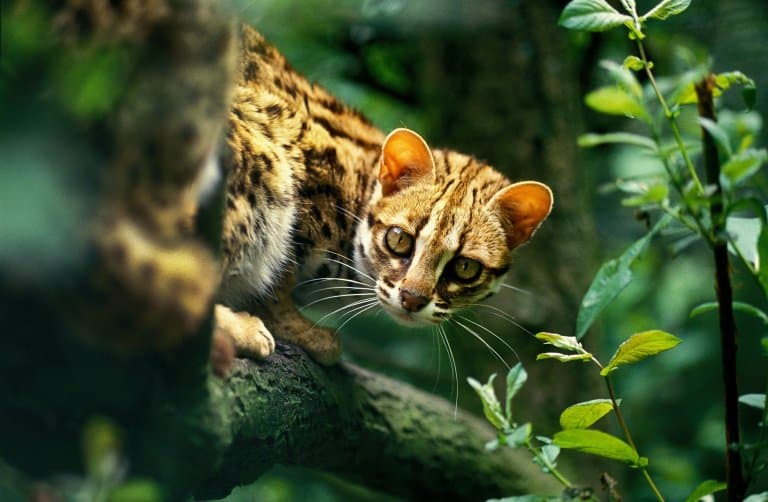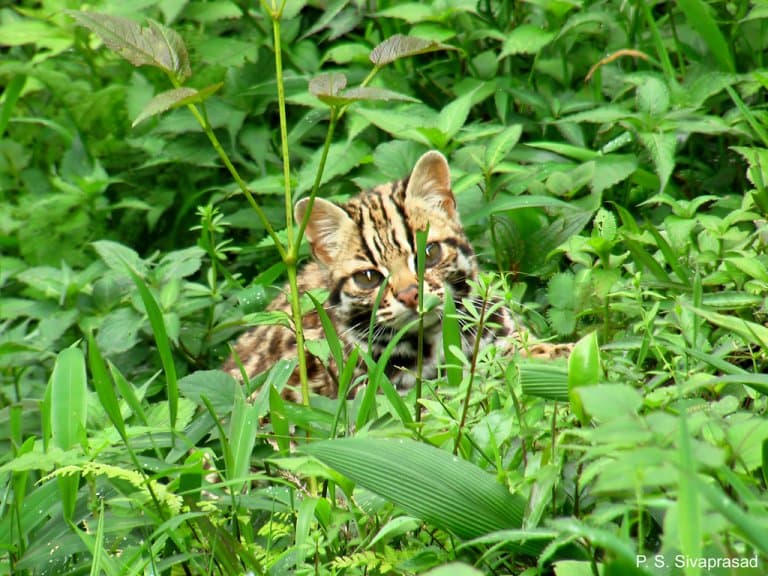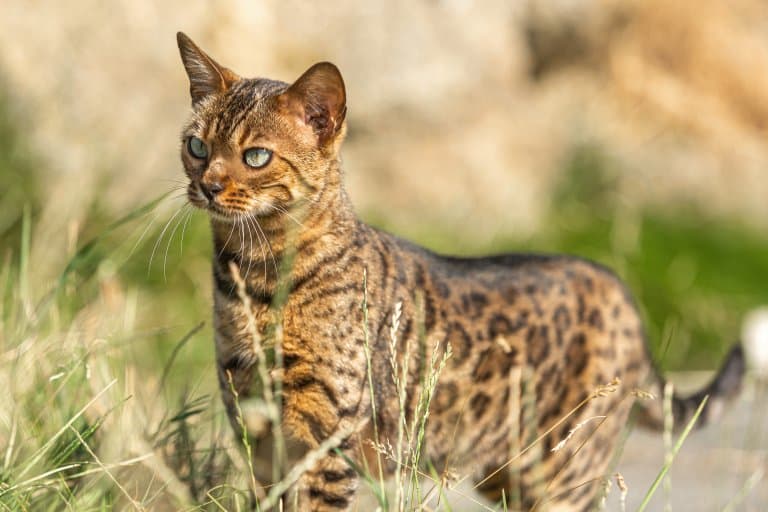Leopard Cat Profile
The leopard cat is a widely distributed wild cat species found throughout Southern & East Asia. These cats are similar in size to domestic cats, however they have longer limbs and relatively small heads and rounded ears.
This beautiful cat is covered in black, solid spots or black rosettes, with dark and white stripes running down the forehead and they most often have a black-tipped tail. The background coat colour of the leopard cat depends on where they are found, with at least 11 different subspecies recognised.
Generally those leopard cats in more northern regions have lighter-coloured coats while those in the southern part of their range are more orange-brown in colour.
Leopard cats are found throughout an extremely large range in Asia and are one of the most widespread carnivores on the continent. They are a highly adaptable species and therefore are found in a variety of different habitats, from tropical forest, to grassland and even fairly remote islands.
Due to their generalist nature, in both habitat choice and diet, leopard cats can tolerate human disturbance and human encroachment and in more developed areas, they are often found near agricultural settlements.

Leopard Cat Facts Overview
| Habitat: | Variety of habitats from forests to grasslands |
| Location: | Southern Asia |
| Lifespan: | Around 4 years in the wild, longer in captivity |
| Size: | Length, including the tail, up to 1.5m |
| Weight: | Up to 7kg |
| Colour |
Yellow to grey fur covered in black rosettes or solid spots |
| Diet: | Carnivorous, mainly feeding on small mammals and reptiles |
| Predators: | Larger wild cats, raptors and large snakes |
| Top Speed: | Up to 58km/h (36mph) |
| Number of Species: | 1 |
| Threats: | Habitat loss, persecution by farmers. Also the pet, meat and fur trade |
| Conservation status: | Least Concern |
Regardless of the type of habitat or terrain these cats occupy, they are prolific, skilled hunters allowing them to easily adapt to changes in prey abundance. In areas where leopard cats are nearer to human settlements, they will mostly feed on rodents such as mice and rats.
However this species is highly generalist and will catch lizards, snakes, bats and birds when given the opportunity. Larger subspecies also prey on species as big as young deer and very likely take large nesting ground birds. They are also capable of catching fish in river shallows.
Although mostly active during the night, leopard cats will also hunt during the day in areas with little human disturbance. They are equally agile when moving on the ground or through the trees and are considered to be semi-arboreal.
A stealthy nature and quick reflexes gives the leopard cat an advantage when targeted by predators, hence they are not commonly preyed upon by any one predator species. However larger cats such as leopards will opportunistically catch and eat leopard cats and they are also sometimes preyed upon by eagles and snakes, as well as wild dogs.
Despite somewhat resembling the domestic cat, leopard cats are truly wild and thrive off a highly varied diet and unlike many cat species, are often found near water. As well as being incredible climbers, leopard cats are superb swimmers and will readily cross flowing water with ease.
Leopard cats have more webbing between their toes than domestic cats and this and their slender but powerful limbs, help propel them through the water. As they exhibit no fear of water, it is likely that leopard cats will catch fish when foraging near riverbanks. An ability to swim also means they are more likely to successfully escape chasing predators.
Leopard cats live in territories that are marked by scent through urine and scat deposits. The size of their home range is dependent on prey availability and the presence of larger carnivores, and these territories can be as small as 2km2 or larger than 10km2.
Although leopard cat territoriality has not been well studied, it is likely they are not overtly territorial and prefer to avoid confrontation outside of the breeding season. They spend most of their lives living a solitary existence, only coming together to breed or when caring for young.
Female leopard cats usually give birth to an average of 2 to 3 cubs and the cubs are completely dependent on their mother for the first few months of their lives.
Cubs are born in dens under the roots of trees, in rock crevices or hollows in trees and only become fully independent at around 8 months of age. It is unlikely that males play a significant role in caring for the young, however they may remain in the area to protect the female and cubs from other males or occasionally bring food to the nursing mother.
As with most carnivores, leopard cats play a crucial role in controlling prey populations within their habitat. Despite avoiding humans, those that live near farming areas help control rat and mice numbers and this directly benefits crop farmers.
However leopard cats are opportunistic hunters and can also become pests themselves by killing poultry and other small domestic animals. Across much of their range, humans tolerate the presence of leopard cats due to their proficiency at rodent killing and their shy, unobtrusive natures.
Interesting Leopard Cat Facts
1. There are many different subspecies of leopard cat
Different leopard cat subspecies have different colouration, different body sizes and feed on different prey depending on where they are found. 1

2. Leopard cats are one of the most widespread carnivores in Asia
Due to their high adaptability, leopard cats have spread across a huge area of Asia.
3. They are excellent swimmers
Rather than avoiding water, leopard cats will readily cross bodies of water and can swim extremely well. 2
4. Leopard cats are ambush hunters
A hunting leopard cat usually silently stalks its prey before rapidly dashing at it and dispatching it with a single bite to the back of the head.

5. They can catch prey as large as young deer
Although rodents make up most of their diet, bigger leopard cats may catch deer fawn or large birds such as grouse or pheasants.
6. Leopard cats sometimes prey on bats
As skilled climbers, these cats will sometimes catch unsuspecting roosting bats or birds.
7. Leopard cats were domesticated in China around 5,000 years ago
Leopard cats are the most likely ancestor of domestic cats in many countries across Asia.
8. The domestic ‘Bengal’ cat was bred from leopard cats
An exotic domestic breed, the Bengal cat, was developed from breeding leopard cats with domestic cats.

9. They are regularly taken from the wild for the exotic pet trade
Due to their beauty and relative abundance, many leopard cats are illegally caught in the wild and sold in the exotic pet trade or bred with domestic cats to produce the ‘Bengal’ breed. 3
10. In some countries, humans kill leopard cats for their meat and fur
In Japan and China, some people eat leopard cat meat and use their fur for clothing. 4
11. They play an important role in pest control on islands
Subspecies such as the Tsushima leopard cat, help reduce rat and mice numbers on the islands they inhabit. This in turn helps preserve natural fauna on the island.
12. Not all leopard cats are the same species
The genus ‘Prionailurus’ comprises of small, spotted wild cats found in Asia. Some species, such as the Sunda leopard cat, are also commonly referred to as ‘leopard cats’, but are in fact a different species from Prionailurus bengalensis. 5
Leopard Cat Fact-File Summary
Scientific Classification
| Kingdom: | Animalia |
| Phylum: | Chordata |
| Class: | Mammalia |
| Order: | Carnivora |
| Family: | Felidae |
| Genus: | Prionailurus |
| Species: | Prionailurus Bengalensis |
Fact Sources & References
- Fernando L. Sicuro (2015), “Variations in leopard cat (Prionailurus bengalensis) skull morphology and body size: sexual and geographic influences”, NIH.
- (1998), “leopard cat”, Britannica.
- Jiayi Wu (2020), “Summer habitat selection and impacts of human disturbance on leopard cats (Prionailurus bengalensis)”, Taylor & Francis Online.
- “Leopard Cat”, Felidae Conservation Fund.
- “Prionailurus bengalensis leopard cat”, Animal Diversity Web.
